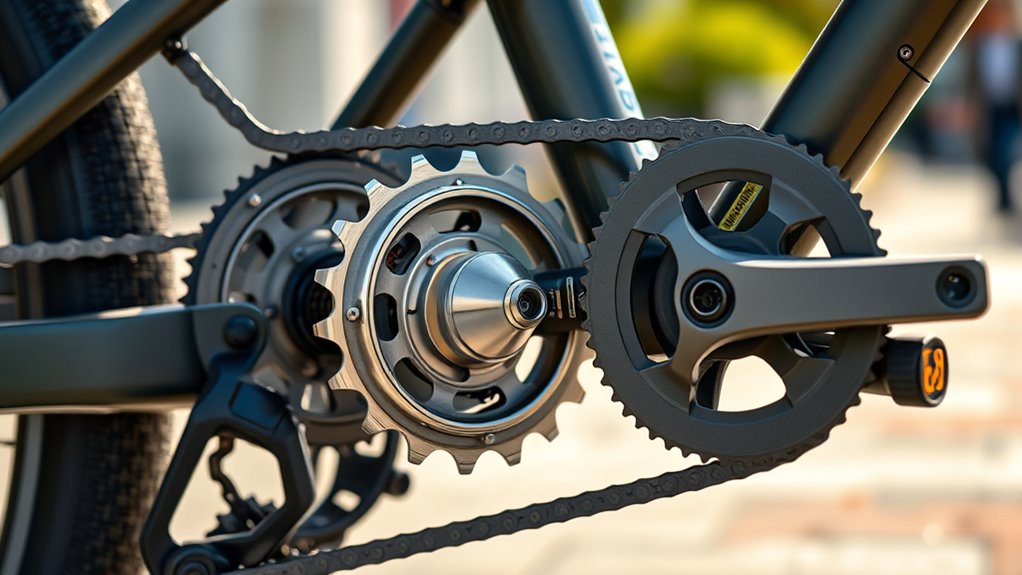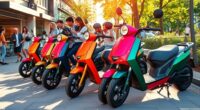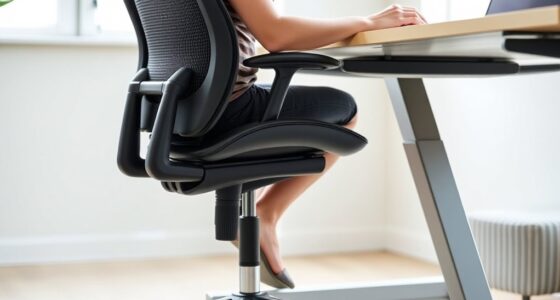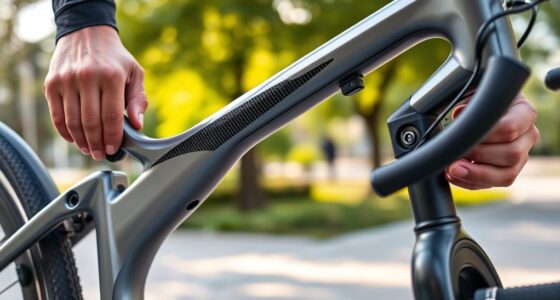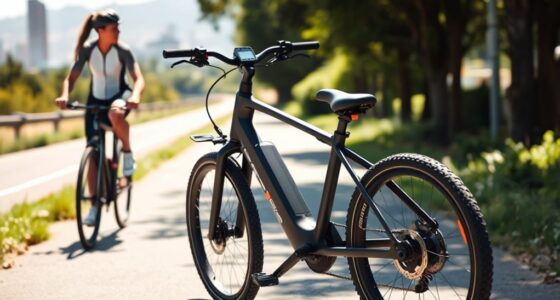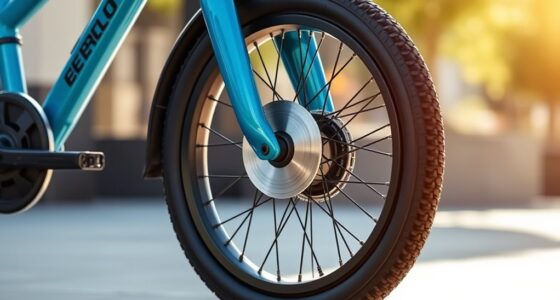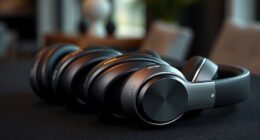If you’re choosing a compact drivetrain for your folding e-bike, internal gear hubs offer low maintenance, weather resistance, and balanced weight distribution, making them ideal for urban riding. They stay cleaner and require less upkeep, but provide fewer gears. On the other hand, derailleurs give you a wider gear range for varied terrain, though they need more frequent adjustments and are more exposed to dirt. To discover which system suits your city rides best, keep exploring your options.
Key Takeaways
- Internal gear hubs offer low maintenance and weather resistance, making them ideal for urban folding e-bikes.
- Derailleurs provide a wider gear range, suitable for varied terrains, but require more upkeep and are exposed to elements.
- Folding e-bikes benefit from the balanced weight distribution of internal hubs for stability during transport.
- Derailleurs may slightly affect bike balance and handling when folded or carried due to external mounting.
- Choose internal hubs for low-maintenance city commuting; opt for derailleurs for versatile riding conditions.
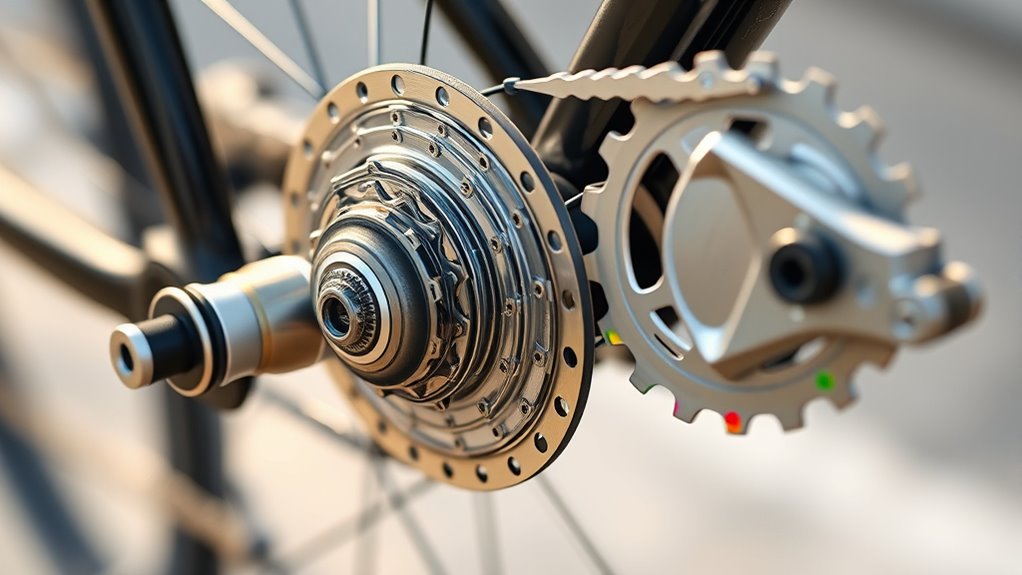
Folding e-bikes have become increasingly popular for urban commuters, offering a compact solution without sacrificing power or performance. When choosing a drivetrain, you’ll want to contemplate how it impacts gear maintenance and weight distribution, as these factors directly influence your riding experience. Internal gear hubs and derailleurs each have distinct advantages and drawbacks, so understanding how they fit into your daily routine can help you make an informed decision.
Internal gear hubs are known for their low maintenance requirements. Since the gears are enclosed within the hub, they’re protected from dirt, dust, and weather, meaning you won’t have to regularly clean or adjust them. This is especially helpful if you ride in city conditions where grime and debris are common. With fewer moving parts exposed, gear maintenance is minimal, saving you time and effort over the long term. Additionally, internal hubs tend to distribute weight more evenly across the bike, helping to improve balance and stability. This balanced weight distribution is particularly beneficial on a folding e-bike, where maintaining a low center of gravity can make folding and unfolding smoother, and riding more comfortable overall.
On the other hand, derailleurs are more flexible and offer a wider range of gears, which can be useful if you encounter varied terrain or want to optimize performance for different riding conditions. However, derailleurs require more regular gear maintenance. You’ll need to keep the chain properly lubricated, and adjustments may be necessary if the gears slip or shift becomes imprecise. Dirt, mud, and grime can quickly clog the derailleur system, making maintenance a bit more involved. Because derailleurs are mounted on the bike’s exterior, they can also affect weight distribution. The added components and their placement can slightly shift the bike’s balance, which might influence handling, especially when the bike is folded or carried.
Ultimately, your choice depends on how you plan to use your folding e-bike daily. If you prefer a low-maintenance, reliable system that stays clean and offers steady performance, an internal gear hub is a strong choice. Its even weight distribution can enhance your riding stability and make folding and storage more convenient. Conversely, if you want a wider gear range for varied terrain and don’t mind regular gear upkeep, a derailleur setup might suit you better. Both options have their merits, but understanding how gear maintenance and weight distribution impact your ride will help you select the drivetrain that best fits your urban commuting needs.
Frequently Asked Questions
How Do Internal Gear Hubs Perform in Wet or Muddy Conditions?
Internal gear hubs perform well in wet or muddy conditions because they offer excellent water resistance and mud durability. Unlike derailleurs, they keep dirt and water out of the gears, reducing rust and corrosion. This means your bike stays smoother and shifts reliably, even in challenging weather. You’ll find that internal gear hubs require less maintenance and last longer, making them a smart choice for riding through rain, mud, or rugged terrain.
Which Drivetrain Type Requires Less Maintenance Over Time?
You’ll find that internal gear hubs require less maintenance frequency over time, making them ideal for hassle-free riding. They have lower repair complexity because their enclosed design protects components from dirt, mud, and water. With fewer adjustments needed and fewer exposed parts, you won’t need to service them as often. In contrast, derailleurs demand more frequent upkeep, especially in wet or muddy conditions, due to their exposed, delicate mechanisms.
Are Internal Gear Hubs Compatible With All Folding Bike Frames?
Internal gear hubs are generally compatible with most folding bike frames, but you should always check the specific frame’s compatibility and hub installation requirements. Some frames may need custom adapters or modifications for proper fitting. Before purchasing, verify the hub’s size and mounting options to ascertain seamless integration. This way, you’ll avoid any surprises and enjoy the low-maintenance benefits of internal gear hubs on your folding e-bike.
How Do Gear Shifting Experiences Differ Between the Two Systems?
Did you know internal gear hubs offer 2-3 times smoother gear changes than derailleurs? You’ll notice that gear change smoothness with hubs feels seamless, especially in stop-and-go city riding. Shift responsiveness is generally quicker with derailleurs, making it easier to adapt instantly to terrain changes. If you prefer effortless, quiet shifting, internal gear hubs excel, but if instant responsiveness matters most, derailleurs give you that immediate feel.
What Are the Cost Differences Between Internal Gear Hubs and Derailleurs?
You’ll find that internal gear hubs generally cost more upfront than derailleurs, making them less affordable initially. However, their lower maintenance and durability might save you money in the long run. When considering pricing comparison, derailleurs usually come with a lower purchase price, appealing if you’re on a tight budget. Affordability factors vary based on your riding needs, maintenance preferences, and how much you’re willing to invest upfront versus over time.
Conclusion
So, whether you choose the sleek, all-in-one internal gear hub or the traditional derailleur’s dance of chains and sprockets, remember: your folding e-bike’s drivetrain is basically the heart of your urban adventure. Opt for the hub, and you’ll enjoy a fuss-free ride that laughs in the face of mud and maintenance. Or stick with the derailleur, risking a mechanical ballet on every ride—because who doesn’t love a little chaos on their compact commuter?
